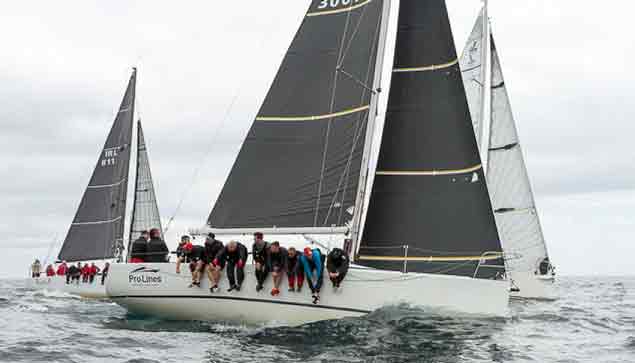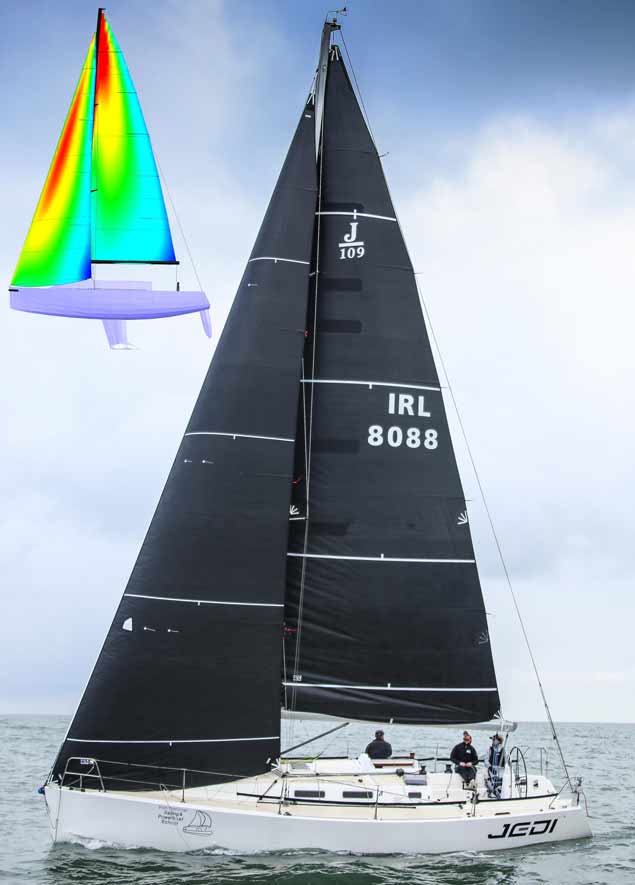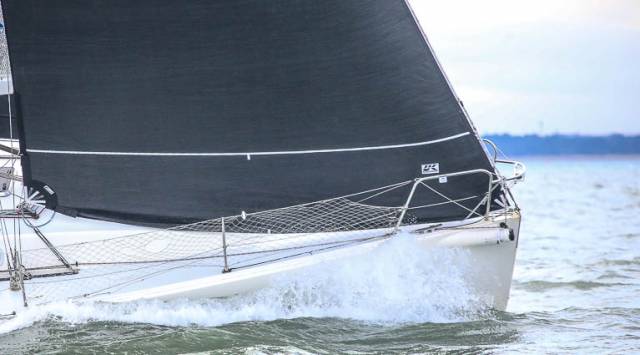In his first article in the ICRA / UK Sailmakers Series, Racing Consultant Mark Mansfield wrote about tuning a fractionally rigged mast. His second article featured changing gears in different wind conditions while racing. In this final article, the four time Olympic helmsman covers how to adjust your mast for varying wind conditions.
The sailing season is upon us, boats are starting to race and many are just in the process of trying to set up their masts, tune the rigs as best they can, and get themselves into a good position. I have already done six full rig tunes on various boats with another four planned for next weekend. Now is the time to go through the process of how to get your mast set up correctly.
In my first article, tuning a fractionally rigged mast, I went through how to set the mast up for base (10 to 15 knots) conditions.
In my second article, I went through how to adjust your sails in varying conditions, using mainly your backstay, mainsheet, traveller and Jib track to get the best out of the sails. In most racing boats, the shrouds and forestay will be pinned with rigging pins, and the adjustments I described in my second article will be what they will do. However at the top end, this is not really enough and you will likely find that the top performers will also adjust their standing rigging (shrouds and forestay) every five knots of wind or so, and likely will end up with a tuning guide, with five different settings. If you look at the J109 Tuning Guide (below) that we have developed, you will see adjustments being made to your rig, every five knots or so.

Some more modern racing boats may have a mast jack, which is a really nice thing to have as you can leave the shrouds as they are and easily soften and tighten the rigging by jacking up the mast (or down). Most boats, however, will have bottlescrews and making adjustments takes more time.
Lighter Wind Rig Changes
So why do you do this? In medium base winds (10 to 15 Knots), the sails should look great by just pulling them in, putting a liitle backstay on and off and away you go. The sails are cut to be good in these conditions without much adjustments required. That is why often you can find less experienced sailors up the front in these conditions. However, say the wind goes down to 7 knots, you leave off your backstay, you will have to ease your mainsheet as the leech tension will still keep the forestay straight. Even with this, you may find that the jib is still not developing enough power, as the forestay is still too firm. Also you may now find the main is a bit too full and as a result you cannot put a lot of mainsheet on as the top closes too quickly. The helm may feel a bit dead and you are starting to put crew down to leeward to try and provide more heel in order to in turn provide some feel on the helm.
Top performers adjust their standing rigging (shrouds and forestay) for every five knots of wind
The reality is, in these conditions, the shrouds and forestay should be eased. Easing the outer shroud (cap) will loosen the forestay and this forestay sag will provide power. If you loosen the outer, then the other shrouds will need to be eased, as otherwise the lowers and diagonals will hold the mast too straight. This is because the outer shroud compresses the mast and forces prebend into it, and loosening it allows it to straighten. Taking a few turns off the forestay also allows the mast to come aft a bit which adds rake and should give the helm more feel.
In very light airs, you loosen even further, for the same reasons.
REMEMBER, IN MOST CLASSES, INC. IRC CLASSES, IT IS NOT ALLOWED TO ADJUST YOUR STANDING RIGGING WHILE RACING (AFTER FOUR MINUTE GUN). ADJUSTMENTS MUST BE MADE BEFORE YOU START RACING.
Stronger Wind Rig Adjustments
Looking at the Tuning Guide above, You will see the exact opposite will happen when the wind is getting stronger. The shrouds and forestay will need to be tightened. This is because, once you go over 15 knots, you are needing to depower. The first and best way to depower, is using backstay, which will straighten your forestay. Once over 15 knots a straight forestay is very important for pointing and also to balance the helm. If the forestay is anyway saggy, too much power will develop.
However to straighten the forestay using backstay there is normally a problem . If your mainsail is cut correctly, then as you progressively harden the backstay, your mainsail should eventually become overflat in the middle, as the backstay will bend the mast too much and take the fullness out. This will be evident when you get overbend wrinkles from the clew of the main up to the middle of the mast.
Some boats may not get these overbend wrinkles and that is either because they have a treetrunk of a mast (which is not good) or they may have a very full mainsail anyway and adding extra mast bend just takes some of this out. That’s all very well, but I would expect that a mainsail like this will be completely too full in lighter airs. If the main is not over bending in stronger winds, that is an indication that is needs some luff curve taken out of it by your sailmaker to make it more balanced in all conditions.
 It is very rare that a mainsail can look fantastic in light, medium and strong wind conditions. As a general rule you design a main, for Irish conditions, to be best in moderate winds and you then either live with it in the other conditions or you adjust the rig to try and get the rig to fit the sail in those light and heavy conditions Photo: Bob Bateman
It is very rare that a mainsail can look fantastic in light, medium and strong wind conditions. As a general rule you design a main, for Irish conditions, to be best in moderate winds and you then either live with it in the other conditions or you adjust the rig to try and get the rig to fit the sail in those light and heavy conditions Photo: Bob Bateman
In addition, a correctly cut mainsail luffcurve means, as you take on Lower and intermediate shroud tension,( in order to keep the mast from overbending), this also stops the mast from sagging to leeward in stronger winds which would close the slot. If your main is cut too full, then easing the lowers is what you might want to do to depower it a bit, but this then allows it to sag to leeward.
As a general rule, the middle of the mast should sag a little to leeward in lighter air as this will develop power. Once you have enough power with all the crew on the side, backstay on and maybe the traveller down a bit then it should be straight sideways. In stronger winds a bit of windward bend in the middle is fine. The reality is, especially with Aluminum masts, in stronger airs the tip of the mast will fall off a bit to leeward which will assist in pushing the middle to windward. Try and have a regular curve if you can. S Bends are slow.
Tightening your forestay will initially reduce your prebend a little, but when you then tighten your Backstay, that prebend will get back to where you want it.
Jib Adjustments in These Varying Conditions
In medium winds, you are looking to have your jib reasonably flat at the bottom, with the leech still slightly open up top. Your halyard tension should not be too hard and if the sail is cut correctly, very small wrinkles will be evident in the luff with the draft (max depth) showing at about 40% from the front. Overtightening the halyard in these condition will move the draft too far forward and flatten the sail. It is very important to get marks on your Halyard to ensure you don’t overtighten. Tying your headsail on with a bowline is no good if you are trying to reproduce halyard tension positions, so best to use a snapshackle or a soft shackle (rope loop—modern option).
As the breeze increases and the backstay is hardened, which tightens the forestay, the jib track position may need to come back to flatten the Foot, while still keeping the leech reasonably tight. Trying to overly twist the leech is not normally a good way to depower as the balance of the boat gets affected with too much weather helm. It is best normally to keep the Jib nailed in and flatten it on the foot in the breeze. You will normally also end up tightening the halyard as the draft will move too far aft and end up cupping the leech
In lighter air, the opposite is the case with the jib. Move the car forward to make the foot more powerful. Loosen the halyard to show additional wrinkling.
With overlapping genoas (comes outside the shrouds), you are constrained by the length of the spreaders. With these sails, you will normally sheet in the sail until it touches the spreader and then you adjust the car for fullness while still keeping the sail just touching the spreader.
With non overlapping jibs, which is now the popular choice on more modern boats – see Photo of J109 – the jibs never come back around the shrouds. Making a few marks with tape on the bottom of the spreaders is very useful as you will find a mark that works well, then you just wind the sail in after every tack and keep the leech of the jib in line with that mark.
 J109s tuning on Dublin Bay. Joker II (right) using UK Sailmakers JX jib mainsail complimented nicely by the test JX jib
J109s tuning on Dublin Bay. Joker II (right) using UK Sailmakers JX jib mainsail complimented nicely by the test JX jib
The modern non overlapping Jib nearly fills the full foretriangle and would be inhauled to bring the sheeting angle in tighter. Very modern boats will inhaul to about 6 degrees, which is extremely tight and the shape of these sails will be cut to allow a bit more twist in the leech so as not to close the slot. A few weeks ago Graham Curren of UK sails did an article showing a new J1 Jib that resulted from an intensive FSI testing and development programme we did on a J109 light jib, This sail was designed to allow this sail sheet to about that 6 degree level. Presently most J109’s can only get to approx. 9 degrees due to the shape and the clew height. This necessitated a very simple adjustment to how the clew height is managed. The results have been very positive.
 JEDI's Uni-Titanium mainsail complimented nicely by the test JX jib. Computerised FSI testing is a crucial element of modern sailmaking
JEDI's Uni-Titanium mainsail complimented nicely by the test JX jib. Computerised FSI testing is a crucial element of modern sailmaking
Adjusting the Rig—Simpler Option
In a perfect world, the adjustments shown in the Tuning Guide would be made before a race and indeed in top level big boat racing worldwide this would be done by very capable, maybe Pro crew. They would be used to doing it and indeed the helm would contribute and might even look for changes based on what he is feeling from the tiller(or wheel).
The problems with all these changes is firstly remembering what changes were made recently and secondly ensuring that while tightening bottlescrews regularly, when you mean to take turns on, sometime by mistake turns are left off. That then leads to S bends being created and sometimes a complete retune of the mast is needed if this happens.
There is another option, which gives most of the benefits of all these changes, but by just adjusting one Bottlescrew. That option is just adjusting the forestay, but by more than you would do if you were also doing the shrouds. So, In the case of the J109, instead of loosening the forestay by three turns in the applicable conditions, you loosen it by five turns. Likewise in the heavier conditions you tighten the forestay more than you would by five turns instead of 3. Tightening the forestay also tightens the shrouds and loosening it, loosens the shrouds. As a result you are getting most of the gains (not all) but you are making it easier to do and quicker. Quicker is important as often just before a start sequence, the wind strength changes, and there is not enough time to make so many adjustments. All of this also eliminates the very damaging situation of incorrectly adjusting the shrouds by mistake, as outlined in the previous paragraph.
I have to say, when I sail on boats where I perform a rig tune, often I will just go down the forestay adjusting option myself. It gives most of the gains, is quicker and more reliable.
Thank you for taking the time to read this, and my previous articles. I am a consultant (and Agent) for UK Sailmakers and we are always trying to help sailors get the most out of their boats and sails. I have a specialisation in Tuning Rigs and am available to any owner (whether you use UK sails or not) to do a full rig tune for them or over a day do a combination of a rig tune and some coaching. I can be contacted at [email protected].
Fair winds and enjoy your sailing
Mark Mansfield
 Article author Mark Mansfield, Professional Sailor and Racing Consultant for UK Sailmakers Ireland Photo: Afloat.ie
Article author Mark Mansfield, Professional Sailor and Racing Consultant for UK Sailmakers Ireland Photo: Afloat.ie
In addition to being a self employed sailing Consultant for UK Sailmakers Ireland, Mark Mansfield is a Professional Sailor. He has been competing for 35–years on the International stage including four Olympics in the Star Class, four Admirals Cups in the 80’s, Commodores Cups in the last ten years and numerous other One Design and big boat campaigns. He has a specialisation in rig tuning and has tuned many of the top racing yachts in Ireland. He also is a noted tactician and was tactician on boats which have won their class in the last 3 ICRA nationals, the last three Volvo Dun Laoghaire Regattas (incl overall boat in 2017), IRC Europeans winner, Cowes Week winner, Spi Ouest winner, Cork Week, Scottish Series, UK IRC winner etc. He is a two times Irish Sailor of the Year and a two times Irish Helmsmans Champion. He is available to sail with, coach, tune rigs or advise on rating improvements for any boat, whether they use UK sails or not. Contact Mark at [email protected] or mobile: 087 2506838
Other articles in the UK Sailmakers Ireland/ICRA 'How to...' Series:



























































